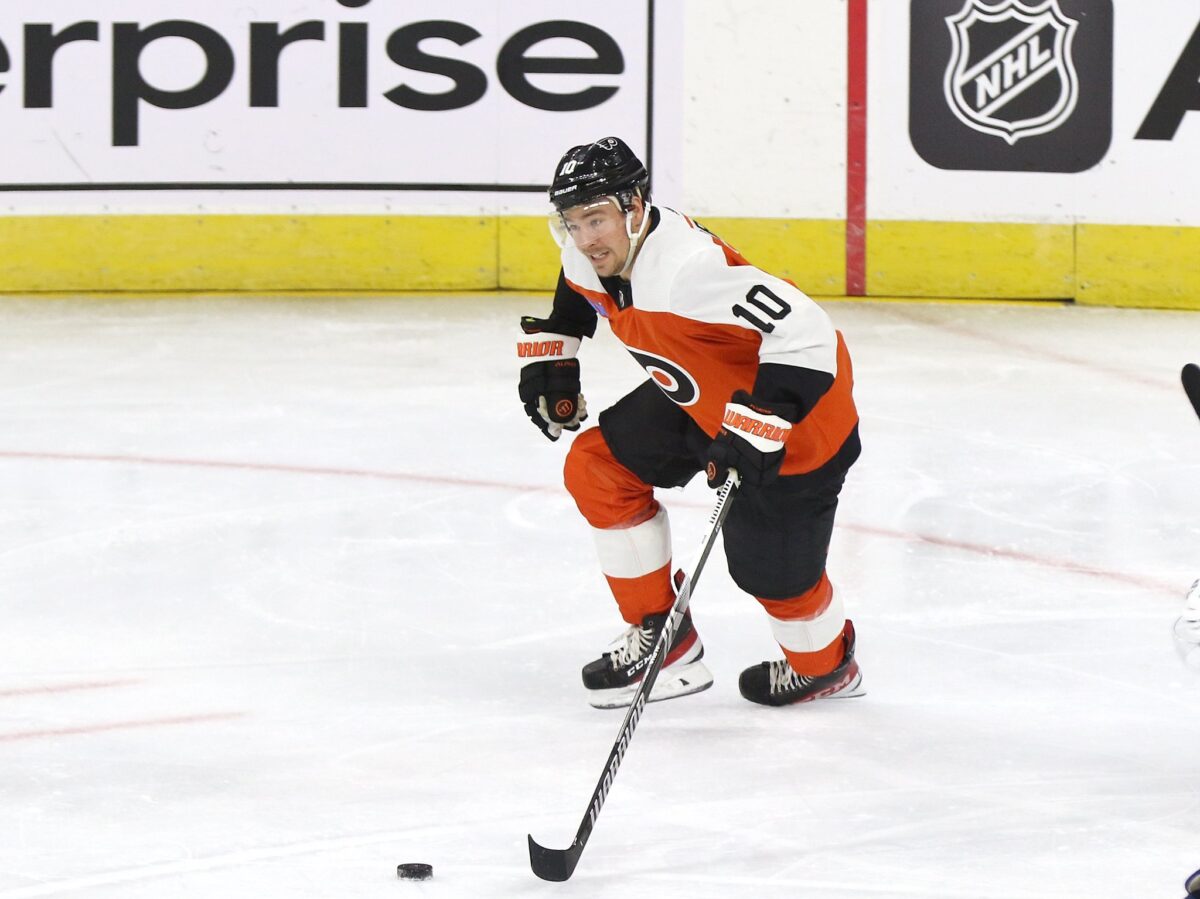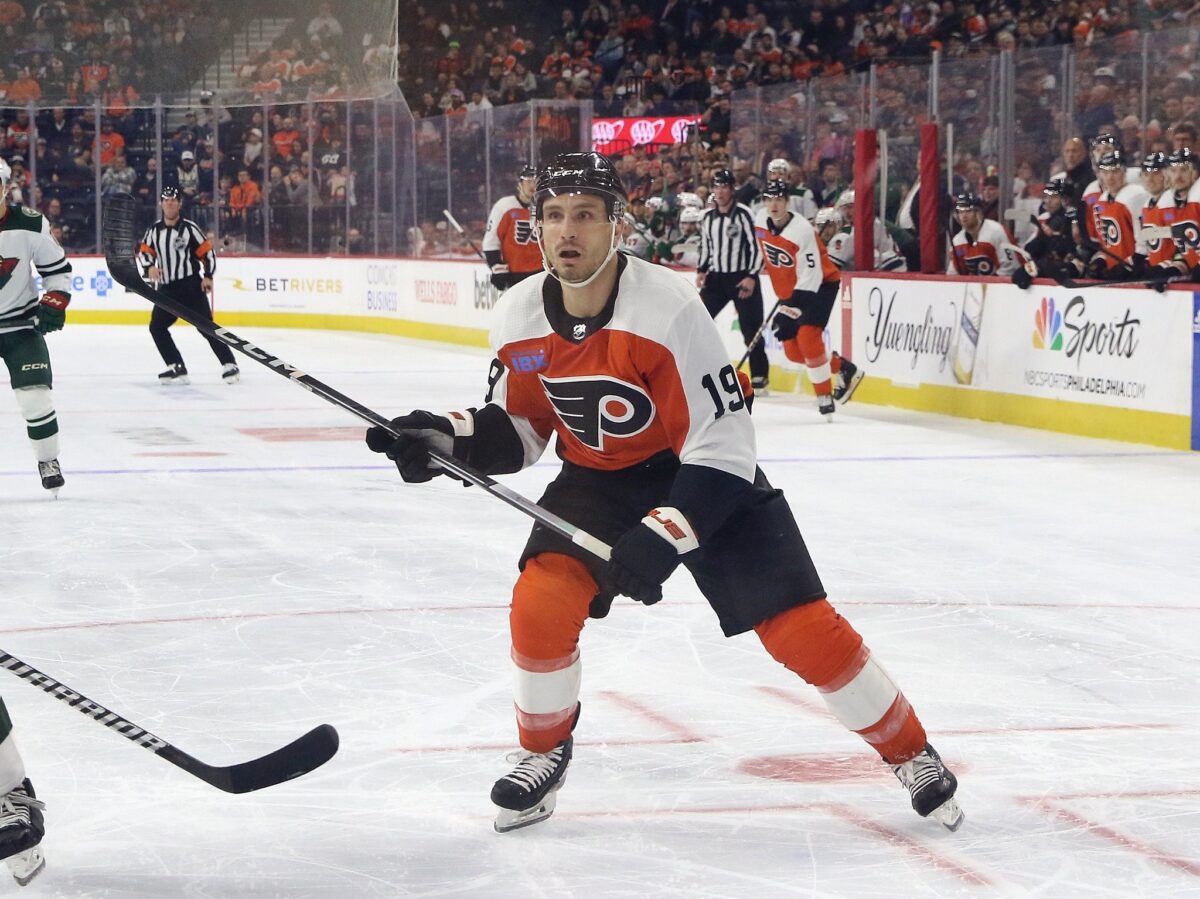On Jan. 22, the Philadelphia Flyers made the decision to send 22-year-old forward Bobby Brink down to the American Hockey League (AHL) to spend some time with the Lehigh Valley Phantoms just over a week before the NHL All-Star Break. 24-year-old winger Olle Lycksell was called up to replace him.
Since the start of January, Brink has been either a staple on the fourth line or a healthy scratch in almost every game after starting the season out with middle-six ice time. Based on his basic and more in-depth numbers as well as those from some of his teammates, he was probably the wrong player to have their minutes reduced and serve as a healthy scratch. Even if this move allows him to get more consistent playing time in the AHL, it was still a questionable one.
Brink’s Season-Long Performance
When looking at Brink’s season as a whole, it has been a stellar one. Just looking at some basic stats, his seven goals and 11 assists for 18 points in 38 games are pretty great for a rookie, tying him for 10th in points among the class with fellow teammate Tyson Foerster. In addition, his plus-7 rating is fourth among rookies, and he shares a 12.7 shooting percentage with phenom Connor Bedard. Though he is one of the older rookies in the class, his campaign has been impressive.

Getting into the more analytical side of his game, Brink has one of the best goals for percentages (GF%) in the entire NHL at 5-on-5. Sitting at 64.7 percent, he is 26th among the 449 forwards who have been on the ice for at least 100 minutes — this puts him in the 94th percentile. When that is limited to just rookies, he is eighth among 54 forwards. When that is limited to forwards on the Flyers, he is only behind Morgan Frost for first on the team.
Brink is one of the better 5-on-5 players in the NHL based on the numbers, and his intangibles back that up. He is a good skater, has a great shot, and is fairly responsible defensively. Though he has been limited to an average ice time of 14:25, he has been one of the sneaky-good players on the Flyers.
He was cruising for a while, but in January he was placed on the fourth line for many games and didn’t produce many points because of that. This was easier to use as justification for making him a healthy scratch and eventually sending him down to the AHL, but he was still fairly good even when placed on the Flyers’ consistently struggling fourth line. If anything, it proved a point that he could flourish anywhere.
Brink Since Having Limited Minutes
Since being demoted to the death sentence that has been the Flyers’ fourth line, with its two most common units having a combined three goals for and nine against for a 25 percent GF%, Brink has ironically been decent. Although he has zero points in his last seven games, he averaged just 10:55 of ice time in the last six of those contests. This doesn’t excuse the lack of offense, but certainly explains it. What does excuse his lack of points is what he has been able to do when he’s on the ice defensively.
In 60:31 of ice time at 5-on-5 since being demoted to the fourth line on Jan. 4, he hasn’t been on the ice for a single goal against, while he has been on the ice for one goal in his favor. Essentially, that’s just over a full-game shutout, and something that netminders Sam Ersson and Carter Hart can really appreciate.

It’s hard to find a real gripe with Brink, especially when looking at the stats. While an argument could be made that he has been unproductive offensively, nobody has been able to get a puck past his netminder since his minutes started taking a hit. In essence, this makes him a perfect bottom-six player on top of having good production for a middle-six forward in terms of points when he was playing those minutes.
The Struggles of Some Teammates
When looking at some of Brink’s forward teammates, specifically Nicolas Deslauriers, Scott Laughton, and Garnet Hathaway, it’s not a pretty sight. While all of them are much older than him and more experienced, they have also not been capable enough to show that they deserve to be in the NHL on a nightly basis, or at least more than their 22-year-old acquaintance.
While Brink ranks in the 94th percentile of GF% at 5-on-5 among forwards who have had at least 100 minutes of ice time, there have been some who have struggled mightily on the Flyers in the same area. Laughton ranks in the 10th percentile at 36.2 percent, while Deslauriers and Hathaway are both in the dreadful third percentile with a GF% of 26.7 percent and 25.9 percent respectively. All three of them are being outscored pretty badly, while none of them have the same offensive production, either.

In 137 combined games, the three only have 29 points in 1,642 minutes of ice time to Brink’s 18 in 534 — it is a bit difficult to find the rationale for this decision if it was made purely to help the Flyers win games. While Brink has played with some higher-quality linemates, Laughton has done the same and still has not been a great fit for the Flyers’ roster. Now over halfway through the season, the hope for some improvement is all but dead. Perhaps a fresh season will be all they need to figure it out, but their 2023-24 campaigns haven’t been the greatest.
The Argument for the Move Still Irrational
The most logical argument in favor of Brink being sent down is that it allows him to get top minutes with the Phantoms and have a profound offensive impact there. While this is true, he was already doing that in the NHL, not just a league that’s a step below it in the AHL. He should have never had minutes taken away from him in the first place and was arguably a prime candidate for more ice time than what he was getting before. He has shown time and time again that he is well above a fourth-line player, but has also proven that he is solid in that role if that’s where he has to be.
At this stage of his career, Brink has already proven everything he needs to. He’s already producing competent NHL numbers, so throwing him in the AHL to “improve his game” doesn’t necessarily make the most sense. Perhaps it can serve as a momentum booster for him if he can ride a scoring streak, but he is a good middle-six player in the best league in the world — there is no reason why he should be sent down to a league that has less star talent. If anything, he might regress due to the sudden change — the NHL and AHL play completely differently, and some players have had difficulty adjusting right away in the recent past.
Related: Jack Campbell Hard to Trade After Remarks by Oilers AHL Coach
Brink might be sent back up to play with the Flyers by the time their All-Star Break ends and they take on the Florida Panthers on Feb. 6, but the idea is that he shouldn’t have been sent down at all. He should be a fixture in the Flyers’ lineup, yet this simply has not been the case.
